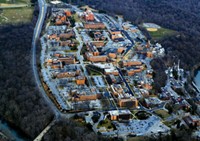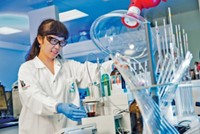Advertisement
Grab your lab coat. Let's get started
Welcome!
Welcome!
Create an account below to get 6 C&EN articles per month, receive newsletters and more - all free.
It seems this is your first time logging in online. Please enter the following information to continue.
As an ACS member you automatically get access to this site. All we need is few more details to create your reading experience.
Not you? Sign in with a different account.
Not you? Sign in with a different account.
ERROR 1
ERROR 1
ERROR 2
ERROR 2
ERROR 2
ERROR 2
ERROR 2
Password and Confirm password must match.
If you have an ACS member number, please enter it here so we can link this account to your membership. (optional)
ERROR 2
ACS values your privacy. By submitting your information, you are gaining access to C&EN and subscribing to our weekly newsletter. We use the information you provide to make your reading experience better, and we will never sell your data to third party members.
Investment
Future-oriented spending begins a tepid recovery in the chemical industry
As companies increase R&D spending, some of those funds are going to incubate external technology
by Marc S. Reisch
April 9, 2018
| A version of this story appeared in
Volume 96, Issue 15

After declining in 2016, future-oriented spending by the chemical industry went on the comeback trail in 2017.
R&D spending increased last year, and while companies pulled back the reigns on capital spending, it was not as hard as they did in 2016.
Spending levels reflected a year during which the global economy gained momentum. Although few managers were willing to bet assertively that the trend would continue, some forward-looking firms took a greater interest in technology start-ups and began committing a sliver of their research budgets to business incubators.
According to C&EN’s annual R&D spending survey, 18 large U.S. and European chemical firms collectively ratcheted up research outlays by 0.6% in 2017 to $9.9 billion. The tepid increase follows a 5.3% drop in 2016, when the group spent $9.8 billion on R&D.
Over the past decade, R&D spending has waxed and waned. A group of 17 companies (excluding Evonik Industries because 10 years of data are not available) spent $9.4 billion on R&D in 2017, up about 18% compared with a decade ago.
However, after adjusting for inflation, spending was at the same level in 2017 as it was in 2007. The share of company sales devoted to R&D usually hovers around 3%, but in 2017 it reached 3.4%, just a tad below the decade high of 3.5% in 2016.
Capital spending declined for the 18 chemical firms in 2017, but not as dramatically as in 2016. The group reduced spending on new plants and equipment by 5.3% to $17.8 billion. The drop follows a precipitous 15.3% decline in 2016.
Capital outlays for the group reached a decade high of $22.9 billion in 2014. The decade low was $12.2 billion in 2009 during the Great Recession.
For the 17 companies on which C&EN has a decade of data, combined 2017 spending on research and capital projects came to $25.9 billion. But considering inflation, the funds headed for future-oriented projects will not buy as much today as they would have 10 years ago. In 2007 dollars, the funds the group spent last year would be worth only $22.2 billion, a bit below spending that year.
Last year, research budgets drew 36% of total future-oriented spending. The decade high was 41.1% in 2009 during the economic slowdown, when managers opted to slash capital spending but protect R&D budgets.

R&D spending in constant dollars was at 2007 levels last year and just under the 10-year peak as a percent of sales.
Note: Values are for 17 chemical firms listed in the "Research investments" table. Excludes Evonik Industries because 10 years of data are not available. Sources: C&EN surveys, White House Office of Management & Budget
Notable in this year’s tables is the inclusion of DowDuPont. Dow Chemical and DuPont announced their engagement at the end of 2015 and tied the knot in August 2017. Separately, the two firms were significant investors in research and capital improvement projects, and they continue to be large investors as one company.
To preserve data on the two firms, C&EN combined historical figures from previous surveys of Dow and DuPont. The company will continue as DowDuPont until 2019 when it plans to split into the agriculture firm Corteva Agriscience, the materials science company Dow, and the specialty products firm DuPont.
Before even tying the knot, Dow and DuPont began repositioning their R&D organizations. Among their many moves was DuPont’s decision to donate a building and labs to form a business incubator at its 150-acre Experimental Station in Wilmington, Del.
Other chemical firms, including AkzoNobel and BASF, are also experimenting with the incubator concept. A complement to the practice of investing in start-ups, incubators allow companies to interact with the smaller ventures and potentially reinvigorate their own businesses. Pharmaceutical companies such as Johnson & Johnson and Bayer long-ago made a similar leap.
In DuPont’s case, the decision to form an incubator at the Experimental Station was meant to inject new life into the firm’s innovation enterprise. “We have innovation centers and R&D centers across the globe to understand customer problems and bring science insights to solve them. But it’s important we are challenged to drive change,” Alexa Dembek, DuPont’s chief technology officer, told C&EN last fall. Dembek added that the incubator would help make the Experimental Station less of a buttoned-down corporate research center and more of an innovation park.
At one time, the Experimental Station housed DuPont’s vaunted Central Research unit. Late in 2015, the firm disbanded the unit and dismissed, according to C&EN sources, more than 200 scientists. Some of those scientists are now working for the Science, Technology & Research Institute of Delaware, a contract research firm housed in the incubator, which is known as the Delaware Innovation Space.
DuPont, the State of Delaware, and the University of Delaware formed the incubator in June 2017. It now has six tenants. The goal is to bring in a total of 50 new firms.
The most recent start-up to join the incubator is Napigen, an agricultural and industrial biotechnology firm cofounded by Ganesh Kishore, former DuPont Pioneer chief biotechnology officer, says Delaware Innovation Space CEO Bill Provine.
The access to support services, including shared equipment, at the incubator helps start-ups progress to their goals, Provine notes. “It’s a great model. There needs to be more incubators in the chemical sector,” he says.
AkzoNobel has also reconfigured a corporate site to accommodate start-ups. The firm recently opened the S/Park innovation center at its R&D complex in Deventer, the Netherlands. S/Park is a partnership with local and regional governments that AkzoNobel hopes will be a breeding ground for innovation in chemistry and technology.
Like the DuPont incubator, S/Park expects to place start-ups in an environment with the host company and other corporate tenants. In addition, AkzoNobel says academic institutes and students will gain access to the facility, which includes safety and analytical labs, scale-up facilities, and education and training facilities—all put together at a cost of $30 million.
Two start-ups have already moved in. Exxfire is a maker of nitrogen-based fire suppression systems. T-Minus Engineering develops atmospheric measurement systems to aid climate and weather research.
“Open innovation is an essential part of our business plan,” says Peter Nieuwenhuizen, the chief technology officer for AkzoNobel Specialty Chemicals. “By exchanging knowledge with our partners, we will be able to develop groundbreaking chemtech innovations much quicker and speed up the introduction of new applications in highly demanding chemistry.”
By 2025, AkzoNobel expects, the Deventer site will accommodate about 300 of its own researchers and those of 10 or so start-ups. The firm hopes that some of the start-ups will be winners of its Imagine Chemistry competition.
Launched in 2017, the competition attracts applicants that pitch their ideas to AkzoNobel judges. Winners get a commercial partnership with AkzoNobel.
The 2018 competition challenges start-ups to come up with solutions in areas such as wastewater-free chemical sites and zero-footprint surfactant platforms. AkzoNobel says 150 firms submitted ideas and that it is in the process of selecting finalists. Some winners will receive rent vouchers good to pay for space at the Deventer complex.
BASF has taken a different approach to the incubator. Instead of housing start-ups at its own facilities, it is supporting independent incubators. At the cleantech incubator Greentown Labs in Somerville, Mass., BASF signed up to support a 24-bench wet lab inside a just-built 5,400-m2 space.

After hitting a decade high in 2014, capital spending has slipped to $17.8 billion and 6% of sales in 2017.
Note: Values are for 18 chemical firms listed in the "Capital outlays" table. Source: C&EN surveys and estimates
The 170-m2 lab, which opened on April 1, will provide affordable space for water, materials, and green chemistry innovators. In an unusual twist, BASF intends to take an active role in the lab, putting one of its own scientists at the bench.
Bernhard von Vacano heads up BASF’s advanced material research partnership with Harvard University, Massachusetts Institute of Technology, and the University of Amherst. Professors at the three schools often launch start-ups, he says, but finding incubator space for them in the Boston area is a challenge. While plenty of biotech incubators exist around Boston, space for chemistry- and materials-related start-ups is harder to find.
BASF envisions helping spin-offs from its academic research projects get space at Greentown. In addition, BASF scientists will take advantage of the facility. “It’s an opportunity to expose corporate scientists to a start-up environment,” von Vacano says.
“Incubators are a logical extension to the open innovation approach” that so many chemical firms endorse, he notes. The firm has a “long history of working with external partners,” including start-ups, he points out.
Sponsoring start-ups at incubators goes beyond the venture capital investment that large firms often make in nascent technology. For BASF, the involvement with businesses inside incubators provides an up-close acquaintance with potentially disruptive technology, von Vacano says.
Although drug company investment in start-ups often occurs at the expense of internal research and researchers, Von Vacano says that won’t happen at BASF.
Instead, he argues that his firm’s researchers are a core asset. Experienced R&D folks who are steeped in BASF’s businesses have the technical and applications expertise to understand the commercial implications of a start-up’s breakthrough technology, he says.
The growing interest among large chemical firms in incubating new companies seem to be more than a passing fancy. As the big boys see start-ups as another window on disruptive technology, incubators are likely to get more attention and an increasing share of corporate innovation budgets.





Join the conversation
Contact the reporter
Submit a Letter to the Editor for publication
Engage with us on Twitter